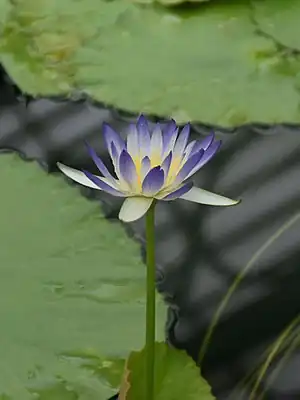Nymphaea subg. Confluentes
Nymphaea subg. Confluentes ist eine Untergattung der Gattung Nymphaea.[1][2][3]
| Nymphaea subg. Confluentes | ||||||||||||
|---|---|---|---|---|---|---|---|---|---|---|---|---|

Nymphaea lukei in den Royal Botanic Gardens, Kew | ||||||||||||
| Systematik | ||||||||||||
| ||||||||||||
| Wissenschaftlicher Name | ||||||||||||
| Nymphaea subg. Confluentes | ||||||||||||
| S.W.L.Jacobs |
Beschreibung
Vegetative Merkmale
Nymphaea subg. Confluentes hat knollenförmige Rhizome. Die Blätter haben einen ganzen bis gewundenen Rand.[4]
Generative Merkmale
Die tagblühenden Blüten ragen über die Wasseroberfläche hinaus. Die Blütenblätter haben keine auffällige Lücke zwischen Blütenblättern und Staubblättern.[4] Die Samen sind kleiner als die von Nymphaea subg. Anecphya.[5]
Taxonomie
Veröffentlichung
Die Art wurde 2007 von Surrey Wilfrid Laurance Jacobs veröffentlicht.[1]
Arten
- Nymphaea elleniae S.W.L.Jacobs
- Nymphaea hastifolia Domin
- Nymphaea lukei S.W.L.Jacobs & Hellq.
- Nymphaea noelae S.W.L.Jacobs & Hellq.
- Nymphaea ondinea Löhne, Wiersema & Borsch
- Nymphaea vaporalis S.W.L.Jacobs & Hellq.
- Nymphaea violacea Lehm.
Etymologie
Der Name der Untergattung Confluentes bezieht sich auf den allmählichen Übergang der Blütenblätter in Staubblätter ohne deutliche Lücke.[2]
Weblinks
Wikispecies: Nymphaea subg. Confluentes – Artenverzeichnis
Einzelnachweise
- Nymphaea subgen. Confluentes | International Plant Names Index. (n.d.-b). Retrieved January 23, 2024, from https://www.ipni.org/n/77081992-1
- Nymphaea subg. Confluentes S.W.L.Jacobs. (n.d.). Retrieved January 23, 2024, from https://biodiversity.org.au/nsl/services/rest/name/apni/212038
- Nymphaea subg. Confluentes. (2020, January 6). Wikispecies. Retrieved 19:06, January 23, 2024 from https://species.wikimedia.org/w/index.php?title=Nymphaea_subg._Confluentes&oldid=7207876.
- null. Nymphaea subg. Confluentes, in (ed.), Flora of Australia. Australian Biological Resources Study, Department of Climate Change, Energy, the Environment and Water: Canberra. https://profiles.ala.org.au/opus/foa/profile/Nymphaea%20subg.%20Confluentes [Date Accessed: 03 February 2024]
- LÖHNE, C., WIERSEMA, J. H., & BORSCH, T. (2009). The unusual Ondinea, actually just another Australian water-lily of Nymphaea subg. Anecphya (Nymphaeaceae). Willdenowia, 39(1), 55–58. http://www.jstor.org/stable/20699149
This article is issued from Wikipedia. The text is licensed under Creative Commons - Attribution - Sharealike. Additional terms may apply for the media files.